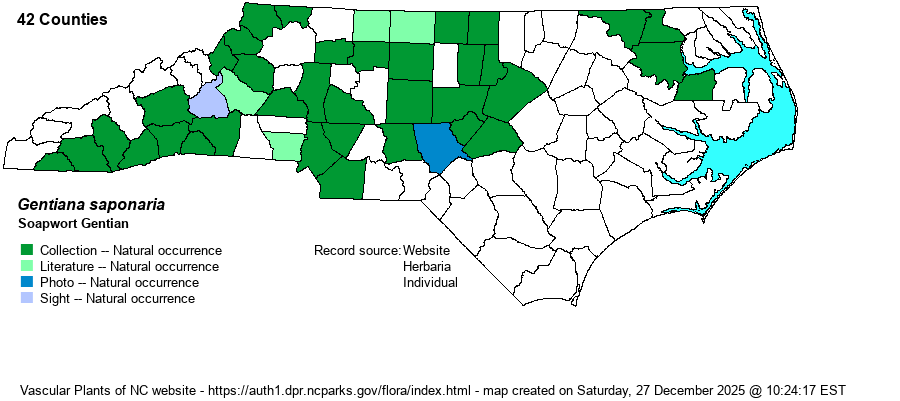| Author | L. | |
| Distribution | Nearly throughout the Piedmont, much of the Mountains, and the northern Coastal Plain. Absent from most of the Coastal Plain (i.e., south of Washington County), and perhaps absent from a few Mountain counties.
This species is scattered over much of the East, but nowhere common. It ranges from NY and eastern IA south to the FL Panhandle and eastern TX.
| |
| Abundance | Uncommon in much of the Piedmont, and in the far northern Coastal Plain. Rare to uncommon in the Mountains, mainly in the southeastern portions. | |
| Habitat | This is mostly a wetland gentian, growing in damp woods, wooded pool edges, wooded stream margins. bogs, marsh edges, and less so in ditches. It prefers shady or partly shady places. | |
| Phenology | Blooms from late September into November, one of the latest blooming of the "bottle" gentians. It fruits shortly after flowering. | |
| Identification | This is the only blue-flowered "bottle" gentian in nearly all of the Piedmont, and the only other one in this province is the pale-flowered G. villosa. However, in the mountains it can be confused with other species, and thus biologists there must take more care in the identification. It is a standard gentian, with paired opposite leaves and a terminal cluster of erect blue "bottles" of flowers. This species can be separated from several others by its smooth stem and leaves. In this species the leaves are mostly elliptical to linear, widest near the middle, as opposed to lanceolate or ovate in most others (that are wider toward the base). The upper leaves and those beneath the flowers are obtuse to acute at the tip, and not narrowed to a sharp point as in most other montane species with smooth stems. The flowers are mostly closed, or nearly closed. The somewhat similar G. catesbyi of Coastal Plain wetlands has ovate leaves, widest near the base, and flowers with a spreading corolla, such that the flower is distinctly open (such that you can stick a finger in the opening!). In general, where this species is found in the same counties as several others (in the mountains), this species is usually found in low elevation wetlands, has narrower leaves that are mostly widest near the middle, has nearly closed flowers, and has a smooth stem. | |
| Taxonomic Comments | The species has often been split into varieties, but one of them -- G. latidens -- has recently been split off as a new species.
| |
| Other Common Name(s) | Harvestbells | |
| State Rank | S3 | |
| Global Rank | G5 | |
| State Status | | |
| US Status | | |
| USACE-agcp | FACW link |
| USACE-emp | FACW link |

